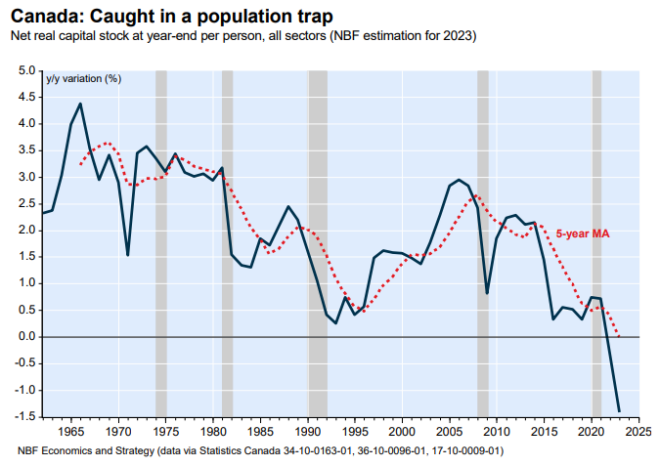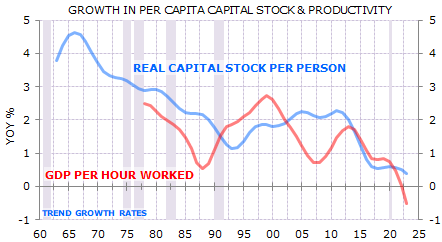Macquarie Bank says Australia has fallen into a “population trap”:
“Population is at the centre of the Australian story as it is working on growth in a ‘positive’ way and on inflation in a ‘negative’ way – and has offset the impact of combined policy tightening.”
“The huge surge in population has pushed up aggregate growth for the entire economy, yet individually, it doesn’t feel like strong growth because everyone is getting a smaller piece of that growing pie.
“Australia’s migration pulse is expected to taper off in 2024, and when this happens, it does not appear that households, business, or trade will be able to fill the growth void.
“We expect gross domestic product (GDP) to slow into stagnation, which we define as between -0.5 per cent and +1 per cent, with prolonged combined policy tightening increasing the risk of recession to 50-50 in the second half of 2024.”
“If an economy’s growth is being driven by immigration, as Australia’s is today, more and more immigration is needed to hold up aggregate growth in the future.
“If population growth slows, then aggregate growth slows, and if there is no other driver of growth, the economy is at risk of recession.”
…“This migration boom also has important long-term macroeconomic implications for productivity, which can structurally impact inflation and complicate RBA policy decision-making”.
Readers will immediately recognise the fair dinkum work of LVO here.
Moreover, it gestures at the same intensifying discussion underway in Canada, which has followed Australia into the “population trap” with identical results of crashed productivity and falling living standards:

An identical result to that calculated for Australia by the marvellous Gerard Minack:
Capital deepening drives productivity. The switch to a population-led growth model has starved Australia of capital deepening investment. The result is declining productivity.

Australia’s population-led growth model was a demonstrable failure in the 15 years prior to the pandemic. Remarkably, the country now seems to be doubling down on the same strategy. The result, unsurprisingly, is likely to be more of the same.
Too right.
Even wet rag Marxist, Guy Rundle, has finally cottoned on at Wokey:
….we have decided not to be a nation-building state, but to continue to build the numbers anyway. Were we still a nation-building state, we would not have spent decades transferring money from public to private to create a vast housing bubble. We would be, in a bipartisan spirit, shaking down the mining industry for some real revenue.
With that, we would get out our pathetic underdevelopment, in which urban development has been handed to shonks to carve up our fringes into transportless non-cities, a rail link to an airport has been debated and delayed for three decades, public trade education systems have been destroyed leaving vast skills shortages, and on and on.
So, the decision might be not that such a state system should be revived, but that we should decide that large-scale immigration has been enough for a while. That decision would not be merely an economic one but also a cultural and existential one as well.
Would it be a wise one, strategically and economically? Not necessarily, but that’s the debate that has to be had. Certain consequences have arisen from continued high immigration, and the destruction of a public education system is one of them.
Why put money into drawing a developing underclass out of poverty and intergenerational exclusion if you can just keep shipping in people willing to work for lower wages for a time? And keep benefiting from exchange rates to make the reward a lot better? We would have to draw people back to work, with proper training, grants, etc, without a ready supply of workers for whom someone else has done the educating.
Secondly, among several issues, there is the question of settler-Indigenous relations. Racial politics hide a grim truth: if the non-Indigenous population in Australia grows significantly faster than the Indigenous birth and identification rate, then First Nations peoples are going backwards.
At 3.8% as of 2021, Aboriginal and Torres Strait Islander peoples are just hanging on to the numerical heft for some influence. Once they go below 2.5%, they’re in trouble. Below 2%, it’s all over. They simply lack the numbers to make the central social agon one of settlement and indigenity. At that point, the agon, the defining struggle, becomes one of residence and arrival. The colonisation project is then completed, not in the red centre but in the international arrivals lounge.
Brushing aside the usual racial obsessions, we can almost glimpse the essential return of class politics at last.
This debate has always been about that.
Australia’s post-2012 experiment with mass immigration has lowered living standards for nearly ALL working people via weak wages, crush-loaded infrastructure, including health, education, and public service. Not to mention a ruined environment.
It has created a permanent foreign underclass of virtual slaves. And a calamitously unfair property oligopoly.
Time to stop it.

